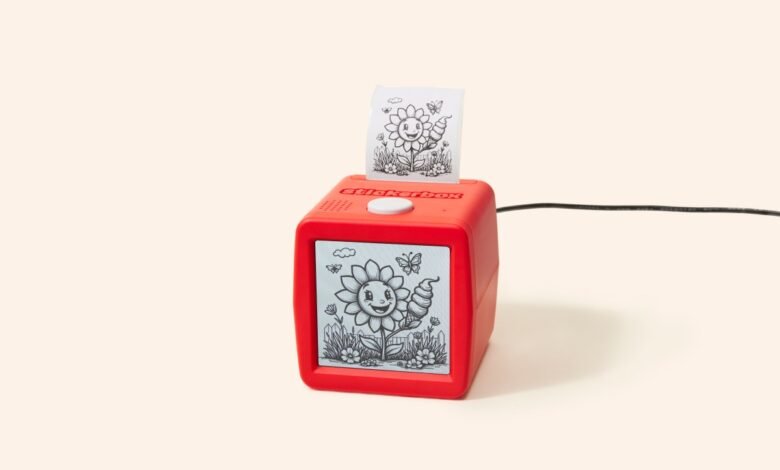Create Fun Stickers with AI-Powered Stickerbox for Kids

▼ Summary
– Stickerbox is an AI-powered voice-activated sticker printer that transforms children’s creative ideas into physical stickers they can color and stick.
– The device surprised testers by offering a new form of creative play that engages children’s imagination without fully outsourcing it to AI.
– Stickerbox uses safe, BPS/BPA-free thermal printing and combines AI-generated images with hands-on coloring activities for balanced play.
– The startup Hapiko developed Stickerbox specifically for kids with safety guardrails that filter harmful content and inappropriate requests.
– Backed by $7 million in funding, Stickerbox is priced at $99.99 with affordable paper refills and plans to add premium features through updates.
Stickerbox offers a fresh approach to creative play by combining voice-activated AI with the tangible joy of physical stickers. This innovative device from Brooklyn-based startup Hapiko transforms children’s spoken ideas into printed images they can color and stick anywhere. Initially skeptical, many parents and kids discover its surprising appeal after giving it a try.
The $99.99 Stickerbox resembles a bright red cube with a black-and-white display and a prominent push-to-talk button. It arrives with three paper rolls good for 180 stickers, a power adapter, and a set of colored pencils. Its design echoes classic toys like the Etch A Sketch, but instead of mechanical knobs, it uses voice commands to guide its AI. Children naturally experiment with describing their imaginative concepts, gradually learning how to articulate more detailed requests without consciously trying to master “prompt engineering.”
Getting started requires a brief parental assist to connect the gadget to home Wi-Fi, similar to setting up a smart speaker. This one-minute process proved straightforward and hassle-free. Operation is intuitive: press the button, describe a picture aloud, release, and watch as the spoken words appear on screen followed by an AI-generated illustration. A thermal printer then produces a physical sticker without needing ink, using paper that is free from BPS and BPA.
There’s a special delight in dreaming up an idea and holding a printed version seconds later. Kids can tear off the sticker and color it using the included pencils or their own crayons and markers. This blends the excitement of generating new images with the focused, calming activity of coloring, much like a personalized coloring book. It strikes a thoughtful balance between engaging technology and hands-on creativity, helping to keep boredom at bay.
As users spend more time with Stickerbox, they learn they can use elaborate, stream-of-consciousness descriptions. The AI intelligently interprets these rambling requests, which is perfect since children often explain things in roundabout ways. You can ask for more than a simple “magical unicorn”, try “a tiny dragon wearing a top hat and roller skates, flying over a rainbow river,” and the device will comprehend.
Hapiko was established this year by CEO Arun Gupta and CTO Robert Whitney, who previously collaborated at the online marketplace Grailed. Gupta had earlier founded the sleep tracker WakeMate, while Whitney led engineering teams at The New York Times’ Games division and later worked at AI firm Anthropic. Whitney’s inspiration came from a moment with his young son, who wanted a custom coloring page. After printing a tiger eating ice cream, his son returned immediately asking for a lizard on a skateboard. Seeing the child’s enchanted reaction, “pure magic”, sparked the idea for Stickerbox.
The founders noticed that while AI enables many new experiences, few are designed with children in mind. They asked: What safeguards are needed? What products make sense? Recognizing that kids possess boundless creativity and constantly develop new interests, they aimed to build a secure, dedicated AI tool for young imaginations. Stickerbox runs on multiple AI models, including proprietary technology that ensures child-appropriate content. It blocks requests involving violence, explicit material, or profanity. Attempting a borderline term like “boobs” might yield a random, harmless sticker such as a cartoon girl, steering kids back toward wholesome fun.
Gupta emphasizes their goal to become a trusted brand so parents don’t feel they must monitor every interaction. Currently, revenue comes mainly from hardware sales, with affordable refills, $5.99 for three rolls (180 stickers). A ongoing promotion includes six rolls with each purchase. Future plans may introduce premium options such as uploading personal photos to insert into fantastic scenes or adding collaborative tools.
As a Wi-Fi-connected product, Stickerbox receives regular firmware updates. Recent improvements added safeguards to encourage original artwork rather than replicating copyrighted characters. An upcoming companion app will let families browse past creations, save favorites, and potentially access premium services.
The company has secured $7 million in funding from investors like Maveron, Serena Ventures, the AI2 incubator, and angels including Matt Brezina and product leaders from top consumer apps.
(Source: TechCrunch)